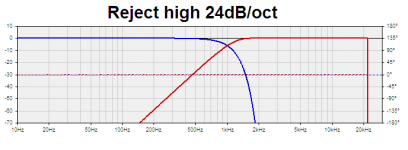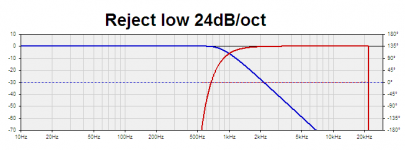Playing filter based on "Reject High". What is behind this option in terms of filter technology?
//
//
This one is to be used to build a complementary asymmetrical crossover, when you want to reject drivers breakups (reject high HP and LP) or to protect a fragile driver use below its comfort zone (reject low HP and LP).
... its called a filter slope and name is as written "Reject high" isn't it 😀 okay joking aside slope is close to BW and fair easy to investigate:
1. On "Linear-Phase Filters" tab set for example HP/Reject high/48dB/1000Hz and with tons of taps in "Impulse Settings" area set for example a number of 524288 and a sample rate of 384000Hz and hit "Generate".
2. Previous point gives a nice trace on graph frozen in a red color so we now have the blue colored trace free for comparison of slopes, now disable previous set "Reject high" filter and go to "Minimum-Phase Filters" tab and try out some of the different filters there, BW 48dB/oct at 1000Hz is fair close for slope trace although it needs some offset in frq, try with a 1050Hz number and finetune with a PEQ set at 1000Hz/Q7/-1dB and we almost there.
1. On "Linear-Phase Filters" tab set for example HP/Reject high/48dB/1000Hz and with tons of taps in "Impulse Settings" area set for example a number of 524288 and a sample rate of 384000Hz and hit "Generate".
2. Previous point gives a nice trace on graph frozen in a red color so we now have the blue colored trace free for comparison of slopes, now disable previous set "Reject high" filter and go to "Minimum-Phase Filters" tab and try out some of the different filters there, BW 48dB/oct at 1000Hz is fair close for slope trace although it needs some offset in frq, try with a 1050Hz number and finetune with a PEQ set at 1000Hz/Q7/-1dB and we almost there.
And to point out the understanding,
Get reject high and LP/HP filter (same for reject low).
not reject high/reject low for LP/HP filter.
🙂
because i've made this &%#)< the first time i used this function...
Get reject high and LP/HP filter (same for reject low).
not reject high/reject low for LP/HP filter.
🙂
because i've made this &%#)< the first time i used this function...
What Thierry means is that "reject low" is not the complement of "reject high".
You choose either one, and use the HP and LP variant to build your crossover.
I should probably change the name as it is quite confusing indeed.
What about "sharp LF" and "sharp HF" ?..
I am open to suggestions! 😀
You choose either one, and use the HP and LP variant to build your crossover.
I should probably change the name as it is quite confusing indeed.
What about "sharp LF" and "sharp HF" ?..
I am open to suggestions! 😀
Errr - maybe I don't get it still. What would RejectHigh + HP give? ( I checked - it gives a HP 😉 )
I think "Reject High" is hard to misinterpret.
//
I think "Reject High" is hard to misinterpret.
//
Last edited:
Hi Thomas,🙂
What is it ? a kind of brickwall ?
What about "sharp LF" and "sharp HF" ?..
I am open to suggestions!
What is it ? a kind of brickwall ?
What is it ? a kind of brickwall ?
That is just an attempt to clarify the "reject high"/"reject low" naming, but it looks like it is a double failure 😀
I will try to come up with a better name.
Errr - maybe I don't get it still. What would RejectHigh + HP give? ( I checked - it gives a HP 😉 )
I think "Reject High" is hard to misinterpret.
//
here high and low refers to frequency, not slope. That naming is very confusing

So, here is the reject high complementary LP and HP (flat summation), useful when you want to avoid breakups and other driver misbehaviors past the crossover point :
here is the reject low complementary LP and HP (flat summation), useful when you want to protect a fragile driver when crossed over outside of its comfort zone, etc. :
Attachments
Last edited:
Perhaps conventional highpass and lowpass with a little explanation bubble if you click on the wording? You could use a different colout font for the wordings that have an explanation.
high pass and low pass options are there, but the problem lies in the names of the filters themselves.
Last edited:
Thanks for the suggestion regarding info bubble, definitely worth exploring!
That said, given then difficulties to explain the concept even on a forum I doubt I will be able to sum it up in an info bubble 😱
That said, given then difficulties to explain the concept even on a forum I doubt I will be able to sum it up in an info bubble 😱
high pass and low pass options are there, but the problem lies in the names of the filters themselves.
I still reverse them and I have been doing this for thirty years! But nonetheless those are the English conventional names for those filters. My guess is that the names make more sense in other languages.
Just checked in google translate. Most languages are a similar translation. French and German are identical, Dutch is close, but makes more sense. Spanish and Italian pretty much the same.
Just my two cents.
I may end up taking a whack at using your program for my home system. Looks quite interesting. And I need to get setup with a proper media PC and soundcard.
Mark, the problem here is really with the "reject low" and "reject high" type of crossovers in rephase, which names are not at all related to high pass and low pass but to the crossover asymmetry.
Oh well... 🙂
Oh well... 🙂
Mark, the problem here is really with the "reject low" and "reject high" type of crossovers in rephase, which names are not at all related to high pass and low pass but to the crossover asymmetry.
Oh well... 🙂
My mistake!
Looks like you have created a little monster problem here! You know little monsters that refuse to go away kind of problem!
I made a "brickwall" filter for my DAC using RejectHigh. 190dB/oct. Maybe this is not suitable?
It sound fine 🙂
//
It sound fine 🙂
//
It can be, but it is more efficient in that particular scenario (steepest possible filter without any other EQ) to use a brickwall filter and let the windowing algorithm shape it.
- Home
- Design & Build
- Software Tools
- rePhase, a loudspeaker phase linearization, EQ and FIR filtering tool

